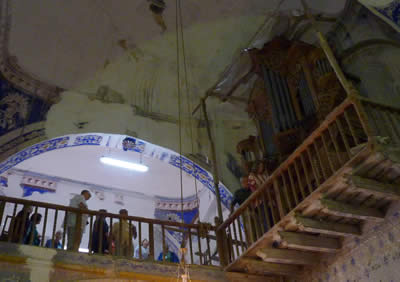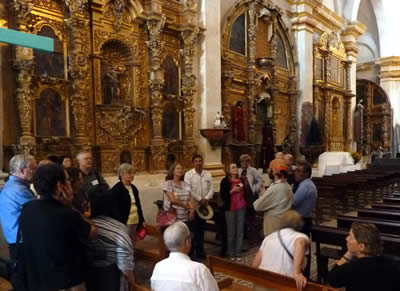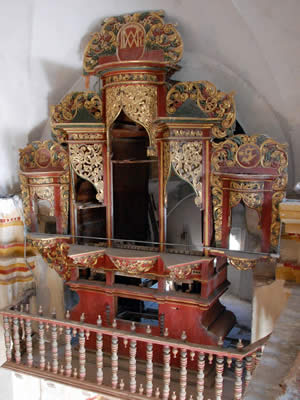EIGHTH INTERNATIONAL
ORGAN AND EARLY MUSIC FESTIVAL
OAXACA, MEXICO
CELEBRATING THE BICENTENNIAL OF THE NATIONAL INDEPENDENCE
AND THE CENTENNIAL OF THE MEXICAN REVOLUTION
OCTOBER 21 - 27, 2010
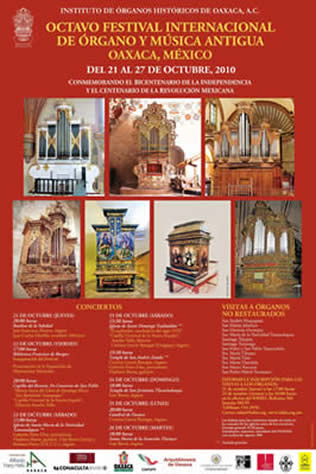
To honor the two most significant events in Mexican political history, the IOHIO presented its grandest festival yet. For the first time, music lovers were able to hear concerts on all seven restored organs, a unique opportunity to appreciate the richness and diversity of Oaxaca´s collection of baroque instruments. In addition we offered three all-day field trips to visit 12 unrestored instruments in village churches, most of which are usually inaccessible to the public; two master classes with the eminent Swiss organist and musicologist, Guy Bovet; two choral concerts, one of which presented choral works that have not been heard for centuries from the early 18th century notebook of Domingo Flores from San Bartolo Yautepec; the opportunity for organists to play the organ in the Basílica de la Soledad; guided tours of two archeological sites; an exhibit of historical material related to the organs from various Oaxacan archives; a talk about the organs and the work of the IOHIO; a view of Oaxaca´s splendid and varied scenery during our field trips to the Tlacolula Valley and the Mixteca Alta; and a chance to sample the local cuisine and revel in the fiesta traditions in the villages.
Oct. 21 (Thursday)
The Festival began with the first of two master classes in San Jerónimo Tlacochahuaya given by the eminent Swiss organist and musicologist Guy Bovet. Thirteen Mexican organists and organ students from Oaxaca, Mexico City, Puebla, Queretaro, Morelia, and Toluca, as well as one from the U.S., played for the maestro and a group of some twenty auditors from Mexico and abroad. His master classes are world-renowned and participants benefitted immensely from his explanation of the fine points of Spanish repertoire and performance practice. Bovet carried out an important survey of Mexican organs in the 1980s and 90s sponsored by UNESCO and Pro Helvetia.

  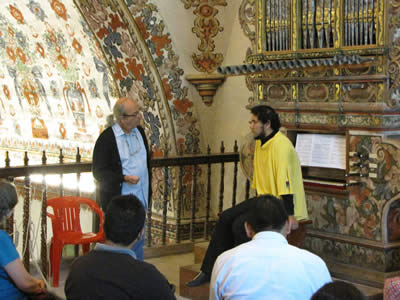
That evening, Mexican artists José Francisco Álvarez (organ) and Juan Carlos Murillo (trombone) offered the First Concert of the Festival in the Basílica de la Soledad. This is the first time the trombone has been featured in a IOHIO festival and the sound blended brilliantly with the organ in a varied program based on arrangements by José Francisco. The magnificent polychromed case of the organ has the date 1686 inscribed on the side of the case, making it the oldest extant organ in Oaxaca.
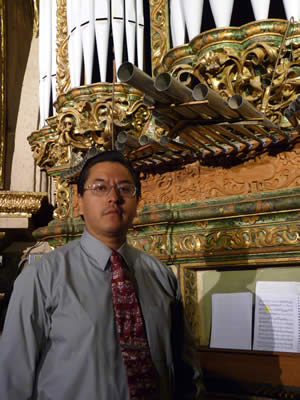  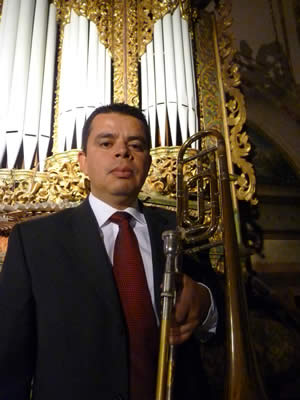
Oct. 22 (Friday)
The second organ master class by Guy Bovet in Tlacochahuaya once again focused on the Iberian repertoire of the 16th and 17th centuries. Participants presented works by Correa de Arauxo, Cabanilles, Bruna, Aguilera de Heredia, Cabezón, and Durón.
 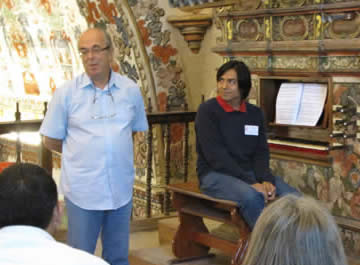
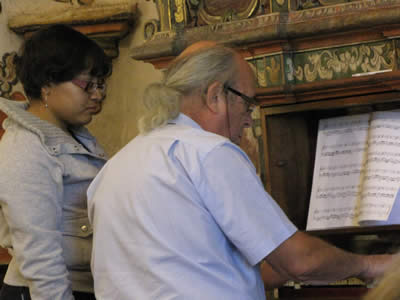 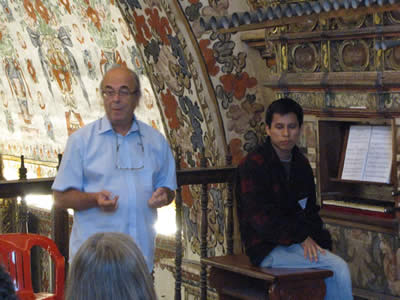
That afternoon, everyone gathered in the elegant space of the Francisco de Burgoa Library in the former convent of Santo Domingo de Guzman for the Inauguration of the Eighth Festival. IOHIO director Cicely Winter introduced Ricardo Fuentes and Beatriz Domínguez from the Coordinación Nacional de la Conservación del Patrimonio Cultural (CNCPN) who spoke about future collaborations with the IOHIO. Next Alberto Compiani and Josefina Benavides from the “Radio Monterrey” station spoke about the weekly radio show “His Majesty the Organ” which Alberto initiated as a result of his ongoing collaboration with the IOHIO. It is hoped that starting next year these programs may be broadcast in Oaxaca.
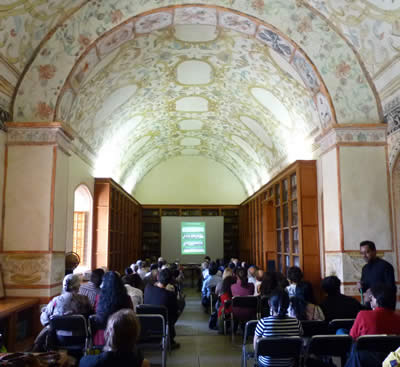
Cicely Winter then offered a presentation about “The Historic Organs of Oaxaca and the Work of the IOHIO”. Her talk was prefaced by special recognition of the initiative of Don Alfredo Harp Helú in support of the restoration and maintenance of the organs.
This was followed by an exhibit of documents related to organs from various Oaxacan archives, “Ad maoirem dei gloriam, el órgano oaxaqueño al servicio del altar,” which afforded an excellent overview of Oaxacan organ history. The exhibit was curated and presented by Polish researcher and former IOHIO collaborator Ricardo Rodys.
 
The Second Concert of the Festival took place in the Capilla del Rosario, (ex-convento de San Pablo) and featured the “Capilla Virreinal de la Nueva España” directed by Aurelio Tello in the presentation of “Music from the Domingo Flores Book (18th century) of San Bartolo Yautepec.”(program) This notebook was part of a treasure of manuscripts discovered by the IOHIO in Yautepec in 2001 and presented during the Seventh Festival.
 
Oct. 23 (Saturday)
The all-day field trip to the Mixteca Alta began with the Third Concert of the Festival in Santa María de la Natividad Tamazulapan. Barbara Owen opened the program with baroque dance pieces. Later Guy Bovet improvised a sonata on a Mexican patriotic tune in the style of Sor María Clara and played a Fandango with the guitarrist Vladimir Ibarra.
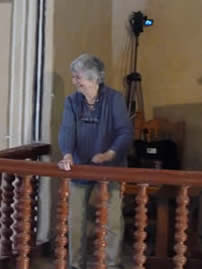 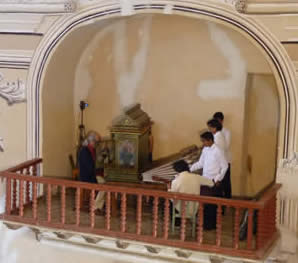
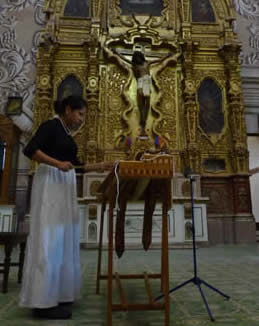
Gabriela Edith Pérez Díaz enchanted the audience with several pieces by J.S. Bach on the marimba. The Ibarra/Pérez duo then closed their program with a piece for marimba and guitar.


At the end of the concert, each of the two IOHIO organ scholarship students from the community played a piece, assisted by their teacher Joel Vásquez.
We did not know that the Pan American Races would take place that day and that the highway was blocked. We were waved through by a police car but did not find out until the end of the day that the friends who drove their own cars to the concert were not allowed to pass.

The Fourth Concert of the Festival in Santo Domingo Yanhuitlán was especially important because this organ has not been played for years due to ongoing restoration work in the church. The combination of the program “The Splendor of the Cathedrals of Mexico in the 17th century,” presented by the “Capilla Virreinal de la Nueva España” directed by Aurelio Tello, the setting in one of Mexico´s most magnificent churches, and the acoustics of the vaulted stone space transported the audience. The renowned Uruguayan organist Cristina García Banegas accompanied the choir and enhanced the program with several magnificent 17th century solo works.
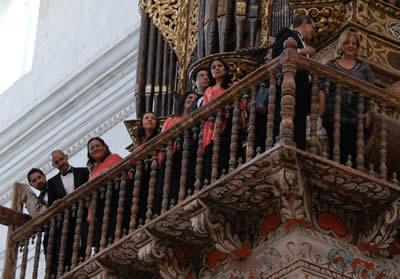

Thanks to the ongoing support of the Federal Road and Bridge Commission (CAPUFE), a special entrance was opened from the super highway, allowing us direct access to San Andrés Zautla and saving us over an hour of travel time. The fiesta and concert in Zautla are always a highlight of the Festival. We were received in the atrium of the church by the local band with noisy fireworks, mezcal, and dancing, with the elderly women of the town dressed in their traditional skirts and blouses. We enjoyed a delicious stew with squash seed sauce, a special local recipe, served in the patio behind the church.
�
� 
�After dinner, we filed into the church to hear the Fifth Concert of the Festival, presented by organist Cristina García Banegas in alternation with Gabriela Edith Pérez Díaz, percussion, and Vladimir Ibarra, guitar. Cristina´s program combined light 18th century dances with more modern works, including one of her own compositions, while Gabriela and Vladimir offered modern works for guitar and complete percussion ensemble. The case decoration of this 4´ table organ (1726) is among the most elaborate in all of Mexico.
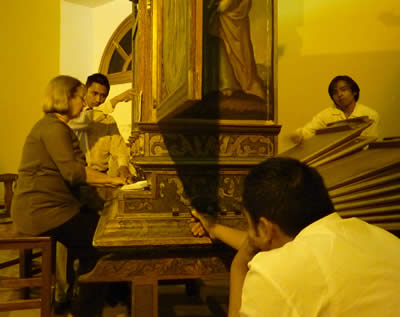 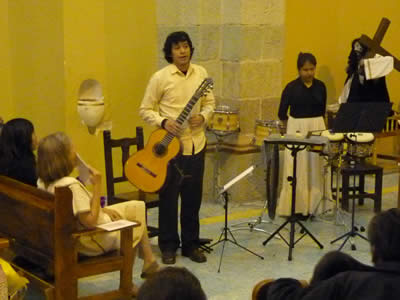

Oct. 24 (Sunday)
This day was dedicated to visiting unrestored organs in the Tlacolula Valley. Our first stop was in San Matías Jalatlaco, located just on the edge of the historic center of Oaxaca City. This lovely 8´ organ, painted blue, was built in 1866 by Pedro Nibra and though missing some pipes, is quite restorable.
We continued on to San Andrés Huayapam and its lovely country church with a splendid gilded altarpiece. The 4´ table organ (1772) is in nearly perfect condition and would require little to make it playable. We were refreshed by a drink of tejate, a specialty of this community.
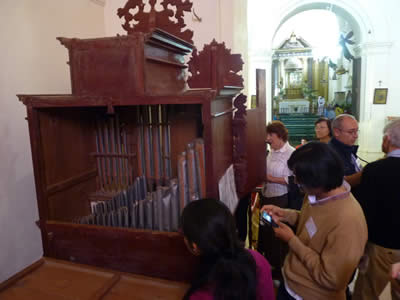 
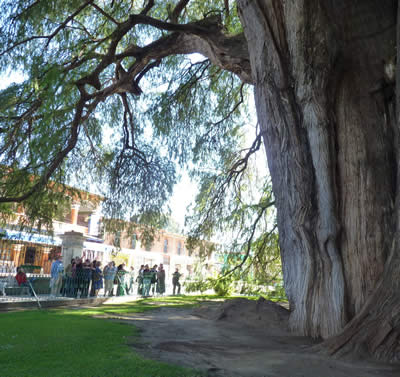
We made a brief stop at the famous tree in Santa María del Tule before proceeding to Santa María Tlacolula. It was market day and a local saint was also being celebrated, so the streets were packed and it was difficult to get one´s bearings because of the tall tents and rides. First we viewed the little 2´ 18th century processional organ, the smallest in Oaxaca, which was built for a small chapel. Then we climbed up to the choir loft to see the 8´ organ in the choir loft. Dating presumably from the mid-18th century, this stately organ is nearly complete and has the most elaborately painted façade pipes in all of Mexico.
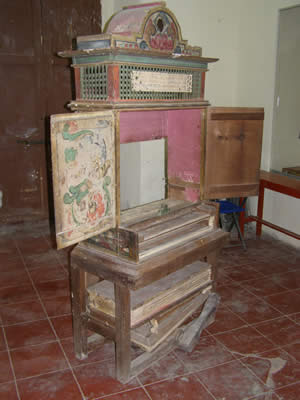


We were all set to proceed to Mitla for lunch but a police car was blocking our vans and it took at least a half hour to track down the driver and convince him to move. As a result we had to rush through the rest of the day. After our midday meal in Mitla, we zoomed to San Dionisio Ocotepec to view one of Oaxaca´s earliest and most important organs (1721). This 4´ stationary instrument, though missing many parts, is the closest relative to the Tlacochahuaya organ. Its doors, which now hang in the sacristy, were brought to the choir loft for viewing. One of them depicts King David playing his harp and the other, Santa Cecilia playing the Ocotepec organ, showing the bellows behind and the original façade decoration.


We arrived in San Jerónimo Tlacochahuaya just in time for the Sixth Concert of the Festival. Guy Bovet offered an elegant program combining serious works of the Spanish repertoire with lighter pieces such as verses from the Sor María Clara notebook. His program ended with an improvisation on the Oaxacan tune “Amor Juvenil” with the 15-year old son of the sacristan on the trombone. This organ (ca. 1735) is the jewel in the Oaxacan crown. Its gorgeously decorated case and façade pipes make it a work of art in its own right and it synchronizes perfectly with the acoustics and exuberantly painted decoration of the church.
Oct. 25 (Monday)
Participants had the choice of playing the organ in La Soledad or going on a guided tour of archeological site of Monte Albán with Marcus Winter of the INAH. There was free time for the rest of the day.
 
The Seventh Concert of the Festival was presented that evening in the Oaxaca Cathedral by Cristina García Banegas (program). Her concert was varied and exciting and included pieces from the Jesuit mission in Chiquitos, Bolivia. There was an excellent turnout for this concert, and Cristina´s connection with the audience was palpable.
 

Oct. 26 (Tuesday)
We departed early in the morning for our two-day journey through the Mixteca Alta. This was only the second time that a concert had been programmed on the organ in Santa María Tlaxiaco, because its three-hour distance from Oaxaca City requires an overnight stay.

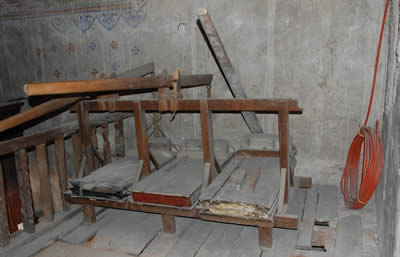
Our first stop was in Santa María Tinú. This small stone church houses an organ (1828) which is disproportionately large for the interior space. The organ, completely intact and played just a generation ago, still grunts and wheezes when the bellows located in the loft above are pumped. It is possible that it could be made to play again with just an overall cleaning and patching of the winding system.
 |
We proceeded to San Mateo Yucucuí. The organ (1743) was never painted but is richly carved. The floor of the high side balcony on which the organ sits is much deteriorated, but the custodian had laid down some planks so that participants could get a closer look at the organ. The situation has been evaluated by the INAH and a repair project is under consideration. |
Santa María Tiltepec is one of several extant organs located near Yanhuitlan. Appreciated by art historians for its richly carved façade, this 17th century church houses one of Oaxaca´s oldest organs (1703) unique in both its construction technique and whimsical carved and painted decoration.
 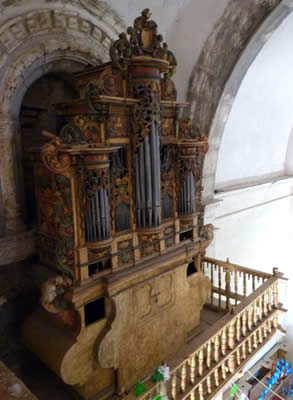
After lunch in Teposcolula, we ascended up through the pine forest to Santa María Tlaxiaco. Guy Bovet´s presentation of the final Eighth Concert of the Festival (program) included some of the most stirring pieces of the 17th century repertoire and ended with an improvisation on the “Canción Mixteca.” This beautiful 8´ organ, the only 19th century restored instrument in Oaxaca, offers a broad palette of sound possibilities which resound throughout the beautiful church.
 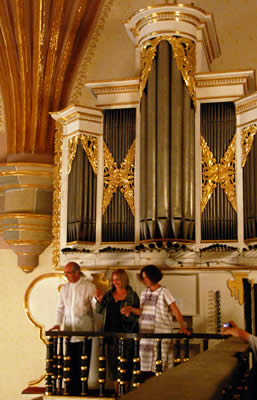
Oct. 27 (Wednesday)
After breakfast, we departed for the pre-classic and classic Mixtec archeological site of San Martín Huamelulpan for a guided tour by Marcus Winter of the INAH and a visit to the community museum.
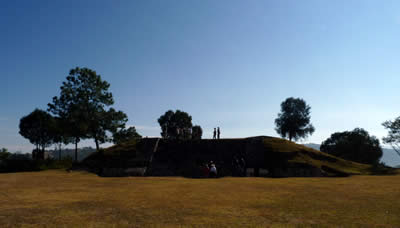 
 |
From there we went to the nearby village of San Pedro Mártir Yucuxaco. The table organ here (1740) is complete and in excellent condition, even though its bellows no longer exist. It closely resembles the organ in Zautla, though without the painted decoration, the carved pipeshades include faces in profile, and the keyboard is one of Oaxaca´s most exquisite.
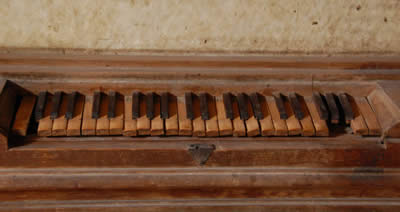
|
The open chapel, church and ex-convent in San Pedro y San Pablo Teposcolula comprise one of the most amazing 16th century Dominican complexes in all Mexico. A project is nearing conclusion to gild the carved decoration of the 18th-century monumental organ in areas where there was no evidence of former gilding. The IOHIO was not notified of this project and it is being investigated. The organ has a similar profile to that or Yanhuitlan but is painted a cream color rather than polychromed, probably because of lack of funds at the time of construction..
After lunch, we continued on to Santiago Teotongo, where we could admire the organ as part of one of the most splendid baroque churches in Mexico. The organ seems to date from the mid-18th century because of the resemblance of its profile to the organ in San Mateo Yucucuí (1743). Even though it lost all its pipes and keyboard during the Mexican Revolution, the magnificent gilded and polychromed case still exists.
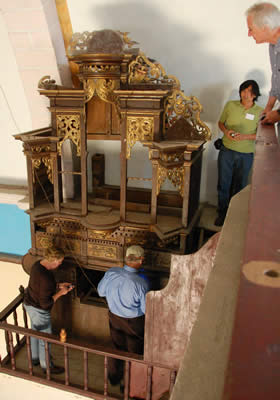
|
Our Mixtec tour culminated with a visit to the church and organ of Santiago Tejupan. This lovely polychromed organ (1776) is the last extant Oaxacan instrument to exhibit religious imagery on the case. Even though it no longer has its pipes or keyboard, the community is most interested in having it reconstructed some day. The name of the donor, cost of the organ and date of construction appear inscribed on decorative medallions on the façade.
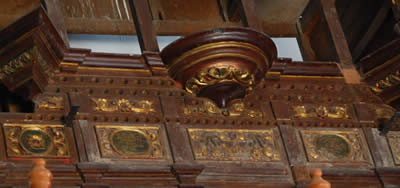
|
Just before getting in to the vans to return to Oaxaca City, Cicely Winter announced that she had a surprise for everyone…a visit to one more organ! (just kidding!)
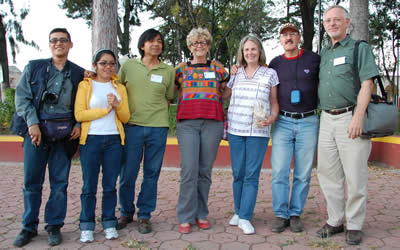
Everyone agreed that the Eighth Festival was spectacular. All the planning and organizational work beforehand really paid off and there were no major glitches, at least within our control. For the first time, we set up a screen and projected the concerts in the church below so that the audience could see the organist and the rest of the activity in the choir loft and this proved to be enormously successful. Three of the organ concerts included pieces from the notebook of the Oaxacan nun Sor María Clara del Santísimo Sacramento. The group of participants could not have been more congenial and included organists, organbuilders, organ students, anthropologists, academics, musicians, teachers, restorers, cultural promoters, and other professionals. It will be a pleasure to maintain contact with these wonderful new members of our growing IOHIO community. During the coming year we look forward to presenting more concerts, producing more CDs, continuing our documentation and conservation project, and writing a book about the Oaxaca organs. So when we organize our Ninth Festival sometime in 2012 we will have a lot to celebrate!
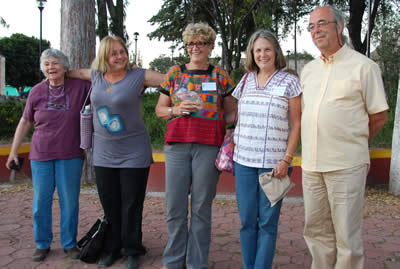
The IOHIO is grateful for the support of the following institutions:
Fundación Alfredo Harp Helú Oaxaca A.C.
Instituto Nacional de Antropología e Historia (INAH)
Arquidiócesis de Antequera Oaxaca
Secretaría de Cultura del Gobierno del Estado de Oaxaca
Universidad de Valladolid, España
Biblioteca Francisco de Burgoa
Museo Textil de Oaxaca
Caminos y Puentes Federales (CAPUFE)
We are also grateful for the support of the following Oaxacan businesses:
Hotel Casa Arnel
Hotel de la Parra
Hotel Marqués del Valle
Hotel Parador San Agustín
Hotel Principal
Hostal de la Noria
Proveedora Gráfica de Oaxaca
|


